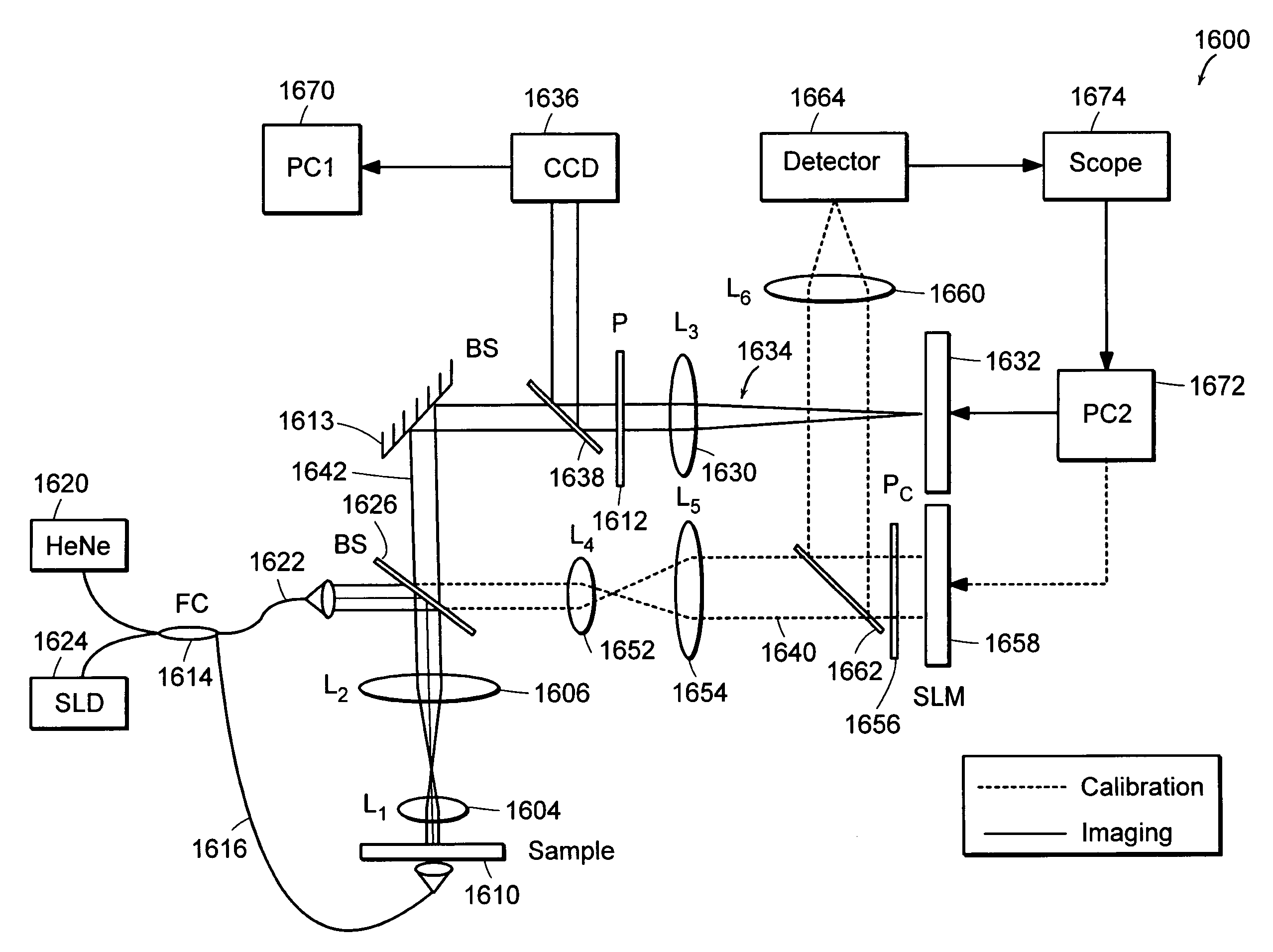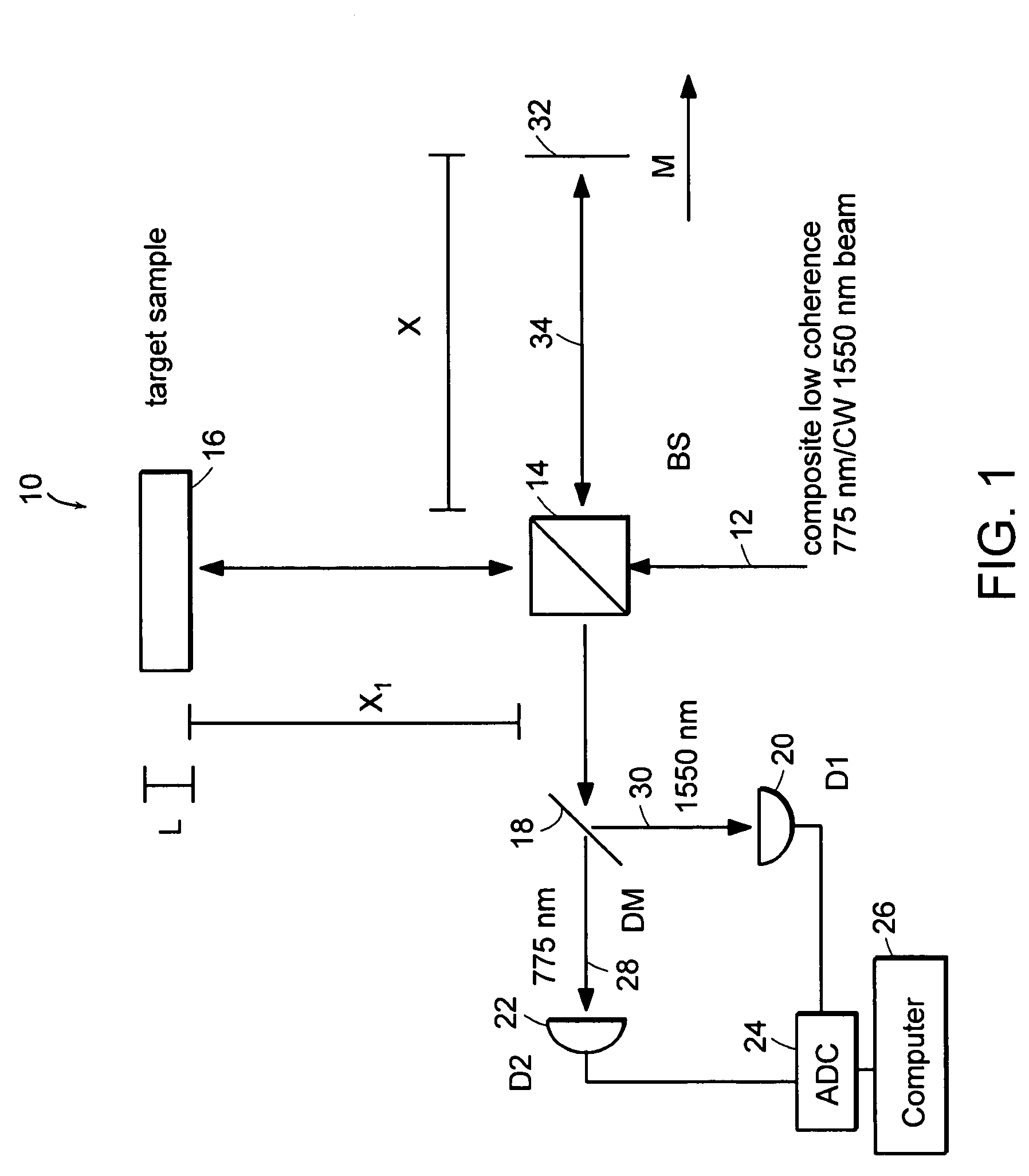Systems and methods for phase measurements
a technology of phase measurement and system, applied in the field of system and method for phase measurement, can solve the problems of limited use of such techniques, inability to implement, and method cannot be fixed on a slab of material, and achieve the effect of accurately determining the dispersion properties of biological tissues and accurate measuremen
- Summary
- Abstract
- Description
- Claims
- Application Information
AI Technical Summary
Benefits of technology
Problems solved by technology
Method used
Image
Examples
example 1
Phase Imaging of a Calibrated Sample
[0330]In this example, a well calibrated sample has been investigated and illustrates that the present invention can provide quantitative information at the nanometer (nm) scale. The sample consisted of metal deposition on a glass substrate, followed by etching. The metal deposit pattern was in the shape of the numeral eight and the thickness of the metal layer was about 140 nm, as measured with a nano-profilometer.
[0331]FIGS. 60A-60D show images obtained at four different phase shifts δ for a system using a reflection geometry. FIG. 60A is an image 2000 for δ=0; FIG. 60B is an image 2200 for δ=π; FIG. 60C is an image 2400 for δ=π / 2; and FIG. 60D is an image 2600 for δ=3π / 2.
[0332]FIG. 61 schematically illustrates a relationship 2100 between the electric field E vector 2102 and the high frequency wave vector component of the field, EH, and the low frequency wave vector component of the field, EL. As illustrated in FIG. 61, the y-axis 2110 and the x...
example 2
Phase Imaging of a Phase Grating
[0336]FIG. 64 shows a phase image 2400 of a phase grating with grooves nominally 10 microns wide and nominally 266 nm deep that was obtained using a transmission geometry. In FIG. 64 the z-axis 2402 is in units of nm and the y-axis 2404 and x-axis 2406 are in the units of CCD pixels. The vertical scale bar 2408 is also in units of nm and is provided to further facilitate determining depth (z-axis dimension) from the phase image 2400.
example 3
Phase Imaging of Onion Cells
[0337]In this example, onion cells were phase imaged using a transmission geometry in accordance with the present invention. An intensity image 2500 of the onion cells is shown in FIG. 65 for comparison to a phase image 2550 shown in FIG. 65. In both FIGS. 65 and 66 the y-axes 2502, 2552 and x-axes 2504, 2554 are in units of CCD pixels. The scale bar 2556 in FIG. 66 is in units of nm.
[0338]The intensity image, FIG. 65, represents the first acquired frame where there is no phase shift between the low and high frequency components δ=0. As shown by a comparison of FIGS. 65 and 66, a regular microscope (intensity) image has a very low contrast relative to the phase image obtained in accordance with the present invention. As seen in FIG. 66, the contrast is greatly enhanced in the phase image, where much finer structure of the cell can be distinguished. In addition, the information in the phase image is quantitative to a nanometer level precision and can be tr...
PUM
| Property | Measurement | Unit |
|---|---|---|
| coherence length | aaaaa | aaaaa |
| center wavelengths | aaaaa | aaaaa |
| center wavelengths | aaaaa | aaaaa |
Abstract
Description
Claims
Application Information
 Login to View More
Login to View More - R&D
- Intellectual Property
- Life Sciences
- Materials
- Tech Scout
- Unparalleled Data Quality
- Higher Quality Content
- 60% Fewer Hallucinations
Browse by: Latest US Patents, China's latest patents, Technical Efficacy Thesaurus, Application Domain, Technology Topic, Popular Technical Reports.
© 2025 PatSnap. All rights reserved.Legal|Privacy policy|Modern Slavery Act Transparency Statement|Sitemap|About US| Contact US: help@patsnap.com



